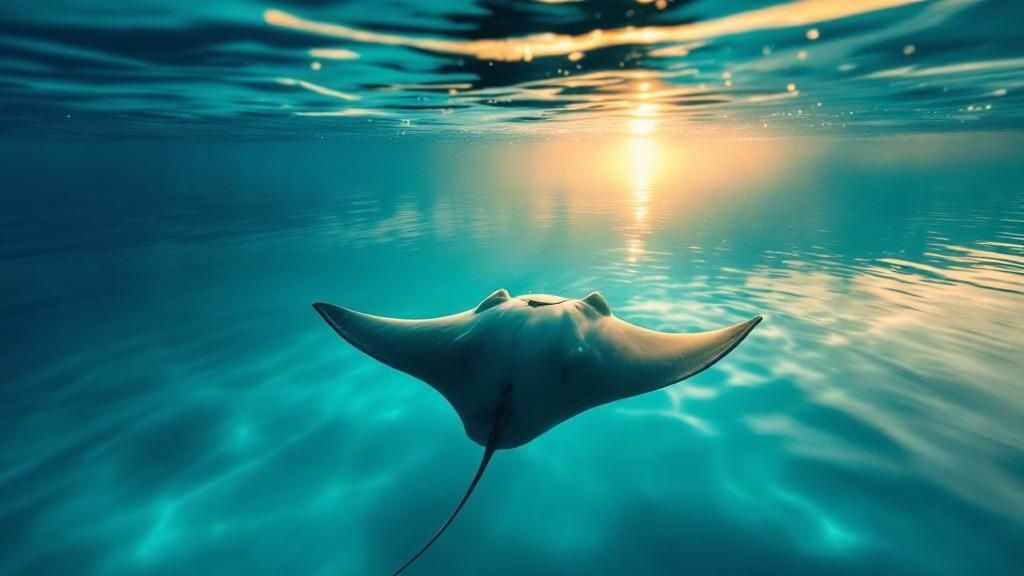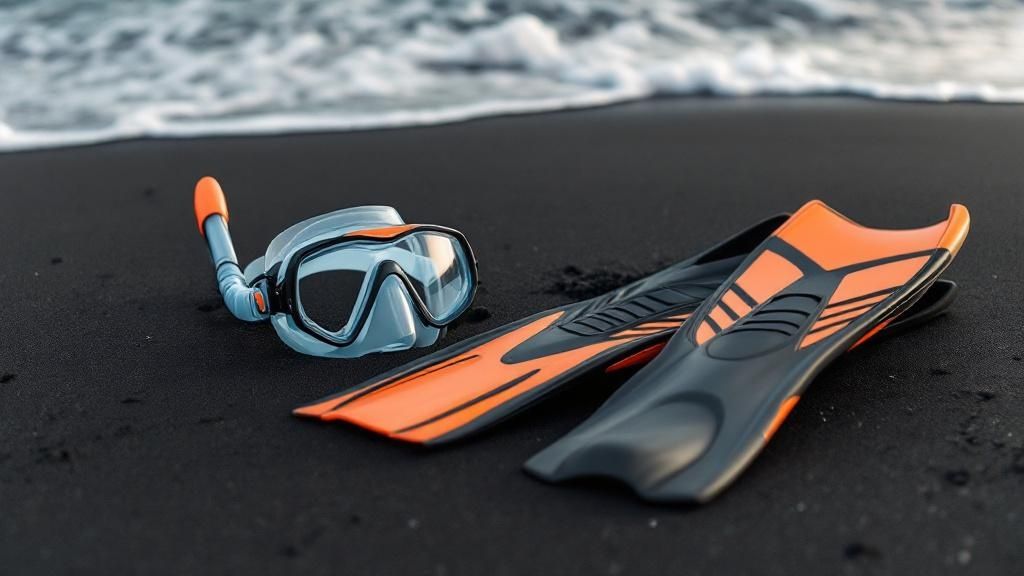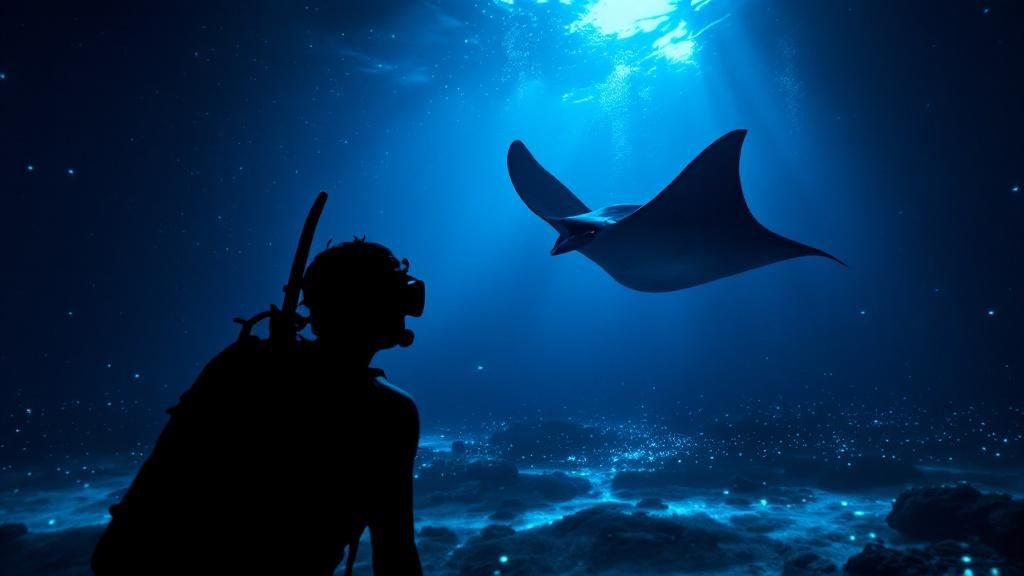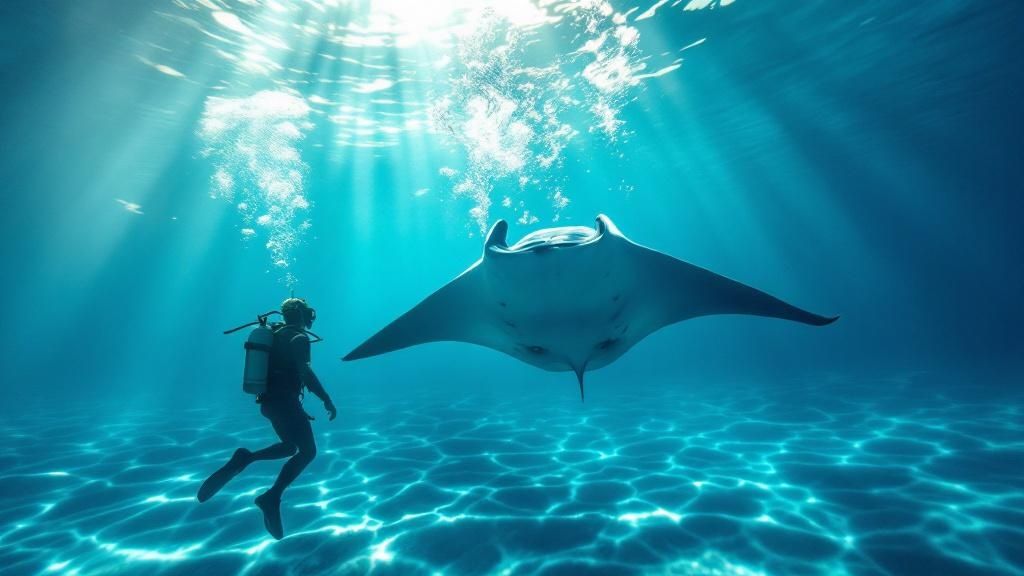Manta Ray Snorkel Kona: Complete Night Adventure Guide
- Byron
- Jun 13
- 13 min read
Why Kona Creates The Planet's Most Reliable Manta Ray Encounters
Imagine gently swaying in the dark Pacific, the ocean cradling you like a hammock. Then, out of the inky blackness, a giant, graceful shape appears, wings stretching up to 16 feet across. This isn't science fiction, it's a classic manta ray night snorkel experience off the Kona coast. Why is Kona such a magnet for these gentle giants? The secret lies in a unique blend of geology and ocean currents.
The Big Island's volcanic landscape creates a phenomenon known as the "Kona Effect." Picture this: volcanic activity stirs up nutrient-rich water from the depths. This, in turn, sparks massive plankton blooms, essentially a giant buffet for manta rays. These blooms draw the mantas to Kona in predictable patterns, unlike other locations where sightings are hit or miss. Kona's consistent food supply creates remarkably reliable encounters.

The volcanic lava rock also forms natural underwater amphitheaters, sheltered areas where plankton can concentrate. Thermal vents and currents further enrich this "plankton soup," making it irresistible to manta rays. This predictable food source makes Kona a snorkeling paradise. The combination of abundant manta rays and an easily accessible coastline makes this an incredibly popular activity, drawing approximately 80,000 snorkelers every year. With sightings occurring 80 to 90% of the time year-round, it's a must-do for any Big Island visitor. Discover more insights about manta ray snorkel Kona success rates. This high success rate practically guarantees an unforgettable experience.
Decoding Manta Ray Behavior For The Perfect Encounter
Manta rays, those graceful ballet dancers of the deep, actually follow surprisingly predictable routines. Once you understand their patterns, your Kona manta ray night snorkel becomes even more captivating. These gentle giants are essentially living filters, sieving enormous quantities of water through their gills to capture tiny plankton. But their feeding isn't random.
These intelligent creatures have learned to associate artificial lights with plankton gatherings, much like moths to a porch light. This learned behavior is the very heart of the magic of manta ray night snorkel tours in Kona. During daylight hours, mantas favor deeper waters. However, as darkness descends, they move towards the shallower reefs where tour boat lights attract their microscopic meals.
The Role of Weather and Moonlight
Weather also plays a significant part in this underwater dance. Calm, clear nights with minimal surface disturbance create ideal viewing conditions. Think of it like looking through a still pond versus choppy water. Strong winds scatter the plankton, disrupting the manta rays' dinner plans and making them less likely to appear.
Even the phases of the moon influence manta ray behavior. Darker nights, with less natural light, often lead to more dramatic encounters, as the artificial lights become even more alluring, concentrating the plankton like a spotlight.
Manta Ray Sightings: A Data-Driven Understanding
Manta ray sightings in Kona aren't just common; they're remarkably well-documented. From 2009 to 2014, detailed records were kept, focusing on individual manta rays and their physical condition. Think of it like a personalized health record for each manta. This meticulous data collection offered invaluable insights into the behavior and health of the manta ray population. Dive deeper into manta ray statistics.
Understanding these interconnected factors – light, weather, and moon phase – explains why some tours result in breathtaking close-up encounters while others are more subdued. It's like understanding the ingredients that make a perfect recipe. Recognizing and interpreting these subtle cues of nature enhances your appreciation for the intricate relationship between manta rays and their environment, making your Kona manta ray snorkel an unforgettable experience.
Finding Your Perfect Manta Ray Tour Match
Planning a manta ray night snorkel in Kona is exciting, but choosing the right tour operator can feel overwhelming. Not all tours are created equal. Picking the right one can be the difference between a so-so trip and an experience you’ll be talking about for years to come. It's like choosing the right hiking guide for a challenging trail – you want someone knowledgeable and passionate who will make the journey safe and memorable.
Key Factors to Consider When Choosing a Tour
One crucial element is group size. The best Kona manta ray snorkel operators keep their groups small and intimate, usually around 10-12 people. This not only allows for a more personalized experience but also minimizes disruption to the manta rays themselves. Think of it like attending a concert – a smaller venue provides a more intimate and enjoyable experience compared to a crowded stadium.
Another vital factor is the guide’s expertise. Experienced guides can identify individual manta rays by their unique belly markings, demonstrating a deep understanding of these fascinating creatures and their habitat. It's like having a local expert lead you through a historical site – their insights enrich the whole experience.
Safety and Conservation: Non-Negotiable Priorities
Safety should always be the top priority, especially during nighttime ocean activities. Reputable operators conduct comprehensive safety briefings, provide well-maintained equipment, and have clear emergency procedures. They also emphasize conservation ethics, adhering to strict guidelines regarding lighting, boat positioning, and interaction with the manta rays. This commitment to responsible tourism ensures the long-term health of these gentle giants and their environment.
The condition of the boat itself can tell you a lot about an operator. A well-maintained vessel with adequate lighting, easy-access entry platforms, and plenty of space for gear indicates a professional and responsible operation. It's like choosing a reliable car for a long road trip – you want comfort and safety.
Speaking of reliability, the manta ray sightings in Kona are remarkably consistent thanks to the area's unique ecosystem. Operators like Jack's Diving Locker report a sighting success rate between 85% and 90%, a figure consistent with other reputable operators in the region. Learn more about manta ray sightings on the Big Island. This high success rate solidifies Kona’s reputation as a premier manta ray snorkeling destination. For more in-depth information, you might find this interesting: Manta Ray Snorkel Big Island: Ultimate Adventure.
When choosing your tour, don’t focus solely on price. Instead, research the operator's success rates, read recent reviews, and ask about their commitment to marine conservation. Prioritizing these factors will ensure your manta ray snorkel Kona experience is not just good, but truly unforgettable.
To help you compare some of the top operators, I've compiled this table:
Kona Manta Ray Tour Operator Comparison Compare key features of top-rated manta ray snorkel operators in Kona
Operator | Group Size | Success Rate | Duration | Price Range | Special Features |
|---|---|---|---|---|---|
Jack's Diving Locker | 12 | 85-90% | 2 hours | $150-$200 | Experienced guides, focus on conservation |
Kona Honu Divers | 10 | 90% | 2.5 hours | $160-$220 | Small groups, personalized service |
Big Island Divers | 15 | 80-85% | 2 hours | $140-$180 | Budget-friendly, longer trip time |
Manta Adventures | 12 | 95% | 2 hours | $170-$230 | High success rate, underwater photography available |
(Note: This table represents example data and should be updated with current information from various tour operators.)
As you can see, each operator offers a slightly different experience, catering to various preferences and budgets. Researching these details beforehand will help you choose the perfect tour match for your Kona manta ray adventure.
Preparing Your Mind And Body For The Ultimate Ocean Adventure
A successful manta ray snorkel trip isn't just about what happens in the water. It's about the preparation beforehand – setting the stage for a comfortable and confident experience. Think of it like getting ready for a relaxed, graceful dance with nature. You don’t have to be a champion swimmer, but feeling at ease in the water and able to float calmly is key. If the open ocean makes you nervous, practicing in a pool or calm shallows beforehand can make a world of difference.
Mental Preparation and Gear Check
Mental preparation is equally vital. Night snorkeling can seem a little daunting at first, but knowing what to expect can turn those nerves into excitement. Imagine yourself floating peacefully in the dark ocean, watching these gentle giants glide effortlessly below. Most tour operators provide all the necessary gear, but the fit is incredibly important. A well-fitting mask is essential to prevent fogging and leaks, which can really interrupt your experience. If you're a photographer wanting to boost your online visibility, this article on SEO for Photography might be helpful.
Properly sized fins, meanwhile, will allow you to move smoothly and efficiently without getting tired. Many experienced snorkelers prefer to bring their own masks and fins to ensure a perfect fit. This allows them to fully immerse themselves in the manta ray experience rather than fiddling with their equipment.
Pre-Snorkel Checklist: Timing and Essentials
The timing of your last meal can also impact your enjoyment. You want enough energy to last, but you don't want to feel unwell on the boat ride. A light, easily digestible meal about 2-3 hours before departure is ideal. Think of how much more you'll appreciate the experience without a full stomach weighing you down. Keep personal items to a minimum and ensure they're waterproof. Leave valuables at your hotel and bring only the essentials, like a small waterproof bag for sunscreen and any necessary medication. This keeps your belongings safe and minimizes the risk of losing anything important.
Finally, go into the experience with realistic expectations and an open mind. Every manta ray encounter is different, and the true magic often lies in simply being present in their underwater world. Embrace the unexpected and you'll be rewarded with an unforgettable adventure. By following these simple preparation steps, you can transform any pre-snorkel jitters into pure excitement, ready to embrace the wonder of encountering these magnificent creatures.

Ocean Safety And Manta Ray Etiquette That Protects Everyone

Swimming with manta rays on a Kona manta ray snorkel adventure is remarkably safe if approached with respect and understanding. These gentle giants are not a threat to humans, but following the proper etiquette is vital for the safety of both you and these incredible creatures.
Think of it like being a guest in someone’s home. You’d naturally follow their house rules out of common courtesy.
The Golden Rules of Manta Ray Encounters
The most important rule is passive observation. Mantas are naturally curious and will often approach snorkelers who are calm and still in the water.
Chasing them or trying to touch them disrupts their natural behavior. It can cause stress and drive them away from important feeding areas.
This means resisting the urge to swim after them, no matter how tempting a closer look might be.
Proper positioning is also crucial. You'll mostly be floating on the surface while the manta rays feed below you, like having premium seats at an underwater ballet.
This gives you an amazing view without interfering with their feeding. Your guide will position the group strategically to maximize viewing opportunities while minimizing any disturbance. Understanding your camera settings and having your files organized beforehand can also help minimize disruption. Check out this helpful resource: Understanding GIF Files.
Respecting Manta Rays: A Hands-Off Approach
Never try to touch a manta ray. Their skin is covered with a protective mucus layer that can be damaged by human touch, making them vulnerable to infections.
Imagine it like a delicate, invisible shield protecting them from harmful bacteria. Even seemingly harmless contact can disrupt this essential barrier.
Flash photography is also typically prohibited. It can disorient and stress the manta rays, impacting their natural feeding behavior.
Following Your Guide's Lead: Safety First
Your tour guide is constantly monitoring the ocean, including the currents, wind, and the manta rays' behavior.
They're trained to recognize changes that could affect safety and will let the group know of any necessary adjustments.
Knowing basic hand signals helps maintain communication underwater, ensuring everyone stays informed and can react quickly to changing conditions.
Staying within the designated viewing area keeps the group together and ensures everyone gets a great view of the manta rays without overcrowding the animals. For tips on choosing the right tour for you, check out: Best Manta Ray Night Snorkel Kona: Top Tours.
Emergency Procedures and Weather Considerations
Emergency procedures are generally simple but are essential to understand before entering the water.
Guides carry safety equipment and maintain radio contact with shore support, adding an extra layer of safety.
Weather conditions in Hawaiian waters can shift rapidly, so always trust your guide’s judgment regarding conditions and timing. Their top priority is always the safety and well-being of both the snorkelers and the manta rays.
Before we head into the water, let's review some key guidelines for interacting with these magnificent creatures. The following table outlines essential do's and don'ts, explaining why they matter and the potential consequences of disregarding them.
Manta Ray Interaction Guidelines Essential safety and etiquette rules for responsible manta ray snorkeling
Do | Don't | Why It Matters | Consequences |
|---|---|---|---|
Remain calm and still in the water | Chase or pursue manta rays | Allows manta rays to approach naturally and reduces stress on the animals | Disrupts natural behavior, drives manta rays from feeding areas |
Follow your guide's instructions | Touch the manta rays | Protects their delicate mucus layer, preventing potential infections | Damages protective layer, increases risk of infection for manta rays |
Stay within designated area | Wander away from the group | Ensures everyone's safety and minimizes disturbance to the manta rays' environment | Compromises safety, increases risk of overcrowding the animals |
Use hand signals to communicate | Shout or make loud noises | Maintains clear communication underwater | Disorients and stresses manta rays, disrupts feeding patterns |
Observe passively | Attempt to ride or grab manta rays | Respects the animals' natural behavior | Causes stress and potential harm to the manta rays |
These guidelines ensure a magical and respectful experience for everyone. By following these simple rules, you contribute to a safe and respectful environment, ensuring a memorable experience for all.
Your Complete Manta Ray Adventure Timeline

Let's walk through a typical manta ray snorkel Kona adventure, so you know what to expect from beginning to end. Picture this timeline as a roadmap for your magical evening, guiding you from the initial harbor meet-up to that incredible underwater encounter.
Setting Sail: Check-In and Boat Briefing
Your adventure begins at sunset at the harbor. You'll check in, meet your guides, and get acquainted with your fellow snorkelers. There's usually a palpable buzz in the air – a blend of excitement and anticipation. This is perfectly normal; you're about to embark on something truly special!
The boat ride to the snorkel site, typically lasting 15-20 minutes, is more than just a transfer. Think of it as a floating classroom. Your guides will give you a rundown of important safety procedures, explain manta ray behavior, and paint a picture of what awaits you in the water. It's the perfect time to ask any questions you have and get fitted with the right gear.
Preparing the "Stage": Arriving at the Snorkel Site
Once the boat anchors at the snorkel site, the crew deploys special underwater lights. These aren’t just for visibility. They serve a crucial purpose, attracting plankton – the main food source for manta rays. It's like setting up a dinner buffet for these gentle giants.
Slipping into the water at night can feel a bit surreal at first. The darkness might seem a little daunting, but rest assured, your guide will stay close by, ensuring everyone feels comfortable and secure. This is where the real magic starts.
The Manta Ray Ballet: Witnessing Nature's Spectacle
As the underwater lights illuminate the ocean, plankton begins to gather, drawing in the stars of the show. Imagine these glowing columns of plankton as spotlights on a stage. Then, the moment arrives – the first manta ray appears, gliding effortlessly through the illuminated water. Their enormous wings, some spanning up to 16 feet, create a truly awe-inspiring sight.
You’ll spend 30-45 minutes in the water, floating peacefully as these majestic creatures perform their mesmerizing feeding ritual below you. They often come incredibly close, sometimes just a few feet away, following their natural feeding patterns. It's a breathtaking spectacle you won't soon forget.
Return to Harbor: Reflecting on the Magic
After the snorkel session, you'll return to the harbor, likely still buzzing with excitement and eager to share stories with your fellow snorkelers. It's a wonderful time to reflect on the incredible experience and appreciate the delicate ecosystem that makes these Kona manta ray adventures possible. The memory of those gentle giants dancing in the illuminated water will undoubtedly stay with you long after you've returned home.
Timing Your Visit For Maximum Manta Ray Magic
Strategic timing can dramatically enhance your manta ray snorkel Kona experience. While these gentle giants are present in Kona's waters throughout the year, certain conditions make for truly special encounters. Understanding Kona's unique environment helps you maximize your chances of an unforgettable adventure.
Imagine a theatrical performance. The main act, our magnificent manta rays, is always there. But factors like lighting and the stillness of the audience (the ocean) can deeply affect how we experience the show.
Calm Seas and Gentle Breezes: The Ideal Backdrop
Calm ocean conditions provide the best viewing. These typically occur during Kona's drier months, often between April and October, when the trade winds are softer and the seas are more tranquil. Think about the difference between looking through a perfectly clean window versus a rippled pond – the calmer the water, the clearer your view of the manta rays gracefully gliding below.
It’s like having the best seats in the house for the manta ray show!
Moon Phases: A Dance of Light and Shadow
Moon phases add another layer of complexity to the manta ray experience. Darker nights often mean more concentrated manta ray activity. The reason? The artificial lights used to attract plankton, the manta rays' main food source, are even more alluring in the darkness, like moths to a flame. It’s as if someone dimmed the house lights to make the spotlight on stage shine even brighter.
However, some snorkelers prefer a bit of moonlight for a more comfortable night ocean experience. It’s a matter of personal preference.
Weather Wisdom: Flexibility is Key
Kona generally enjoys pleasant weather, but being flexible is always wise. Check the forecast before your trip and have a backup plan in case conditions aren’t perfect. Most operators offer alternative dates or full refunds if weather forces a cancellation. This is like checking the concert program notes before a show. It preps you for what to expect and helps you adapt if there are any last-minute changes.
This screenshot shows a typical Kona weather forecast, highlighting the importance of checking conditions before your snorkel. Sunny skies and calm winds are perfect for manta ray viewing, while rain or strong winds can affect visibility and tour schedules.
Booking Strategies: Planning Ahead vs. Last-Minute Opportunities
Booking in advance is important for a successful manta ray snorkel Kona trip. Popular operators often book up weeks or even months ahead, especially during peak season. Just like snagging tickets to a popular show, planning ahead is usually the best strategy.
However, cancellations sometimes open up last-minute spots, so it’s worth checking even if your desired dates look full. You might just get lucky! When planning your manta ray snorkel kona adventure, consider different viewing habits, often influenced by video length. Check out these Social Media Video Length Best Practices for more information.
Location Logistics: Minimizing Travel Time
Staying near Kailua-Kona can minimize travel time to departure points. This lets you spend more time enjoying the experience and less time in transit. Think of it as choosing a hotel near the concert venue – less travel, more music.
Scheduling your manta ray adventure early in your Big Island trip is also a smart move. This provides flexibility for rescheduling if weather interferes with your plans. Many visitors combine their manta ray snorkel with other Big Island activities, such as volcano tours, creating a multifaceted and memorable Hawaiian experience.
For a more in-depth look at the magic of these encounters, you may find this interesting: Why Manta Ray Night Snorkel is the Ultimate Adventure in Kona.
Ready to witness the magic yourself? Book your unforgettable manta ray night snorkel adventure with Manta Ray Night Snorkel Hawaii today! https://www.mantaraynightsnorkelhawaii.com
Comments